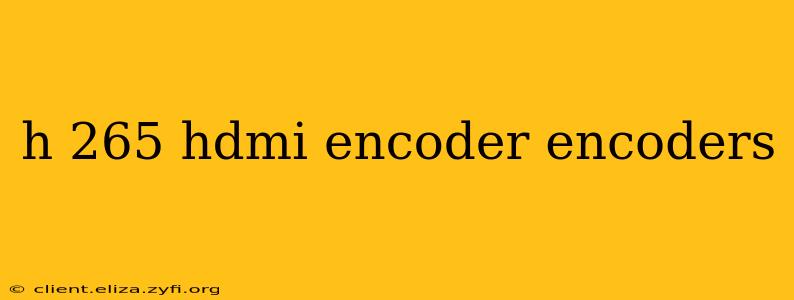The world of video encoding is constantly evolving, and H.265 (also known as HEVC, High-Efficiency Video Coding) has become a crucial player. H.265 HDMI encoders offer superior compression compared to their predecessors, leading to smaller file sizes and higher-quality video at lower bitrates. This guide will delve into the intricacies of H.265 HDMI encoders, covering their applications, benefits, and key considerations.
What is an H.265 HDMI Encoder?
An H.265 HDMI encoder is a device that takes an HDMI video signal as input and compresses it using the H.265 codec. This compressed video stream can then be transmitted or stored more efficiently. The encoder essentially translates the raw HDMI video data into a more compact digital format, suitable for various applications like streaming, storage, and video conferencing. The resulting compressed video file is significantly smaller than one encoded using older codecs like H.264, while maintaining comparable, or even superior, visual quality.
Benefits of Using H.265 HDMI Encoders
H.265 offers several key advantages over older codecs:
-
Higher Compression Ratio: This is the most significant benefit. H.265 achieves significantly higher compression ratios than H.264, resulting in smaller file sizes for the same video quality. This translates to lower storage requirements and reduced bandwidth consumption for streaming applications.
-
Improved Video Quality: For the same bitrate, H.265 often delivers better video quality compared to H.264. This means crisper images, smoother motion, and enhanced detail.
-
Reduced Bandwidth Requirements: The smaller file sizes directly translate to lower bandwidth requirements, making H.265 ideal for streaming over networks with limited bandwidth capacity.
-
Cost Savings: Lower bandwidth consumption and storage needs contribute to significant cost savings, particularly in applications involving large-scale video distribution or archiving.
Different Types of H.265 HDMI Encoders
H.265 HDMI encoders come in various forms, each catering to different needs and applications:
-
Standalone Encoders: These are self-contained units that accept an HDMI input and output a compressed video stream via various interfaces like RTMP, RTSP, or directly to storage.
-
Software Encoders: These encoders are software applications that run on computers, often requiring specialized hardware for efficient encoding. They offer flexibility but may demand more processing power.
-
Embedded Encoders: These are integrated into other devices, such as cameras, and provide H.265 encoding capabilities as a built-in feature.
Choosing the Right H.265 HDMI Encoder
Selecting the appropriate encoder depends on several factors:
-
Resolution and Frame Rate: Consider the video resolution (e.g., 1080p, 4K) and frame rate (e.g., 30fps, 60fps) you require.
-
Bitrate and Compression: Choose an encoder that allows you to adjust the bitrate to balance video quality and file size.
-
Output Interfaces: Ensure the encoder supports the output interfaces you need (e.g., RTMP, RTSP, HTTP, FTP, Onvif).
-
Scalability and Expandability: Consider the potential need for future expansion or upgrades.
-
Budget: The cost of H.265 HDMI encoders varies significantly.
H.265 vs. H.264: Which is Better?
While H.264 remains widely used, H.265 offers clear advantages in terms of compression efficiency and video quality. However, H.265 generally requires more processing power for encoding and decoding, so this should be considered. For applications where bandwidth and storage are significant concerns, H.265 is usually the better choice.
What are the different applications for H.265 HDMI encoders?
H.265 HDMI encoders find applications in a vast range of industries and scenarios:
-
Live Streaming: Streaming high-quality video to platforms like YouTube, Twitch, or Facebook Live.
-
Video Surveillance: Recording and transmitting high-resolution security footage.
-
Video Conferencing: Enabling high-definition video calls with reduced bandwidth needs.
-
Digital Signage: Displaying high-quality video content on large screens.
-
Medical Imaging: Storing and transmitting high-resolution medical images.
How much does an H.265 HDMI encoder cost?
The cost varies greatly depending on features, resolution support, and brand. You can find basic encoders for a few hundred dollars, while professional-grade models can cost several thousand.
What are the key features to look for when buying an H.265 HDMI encoder?
When selecting an encoder, look for features like: supported resolutions and frame rates, bitrate control, output interfaces, low latency for live streaming, ease of use, and robust software support.
This comprehensive guide offers a starting point for understanding and choosing the right H.265 HDMI encoder for your needs. Remember to carefully consider your specific requirements and budget before making a purchase.
